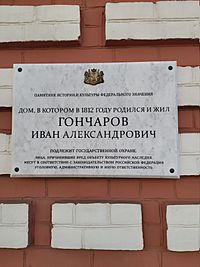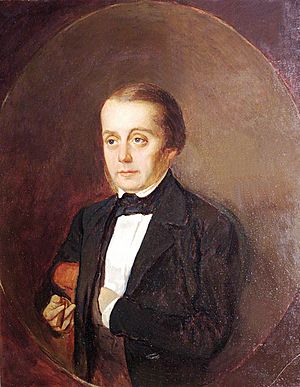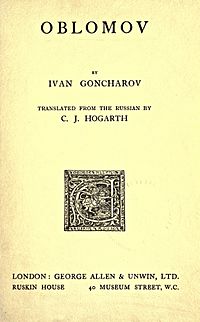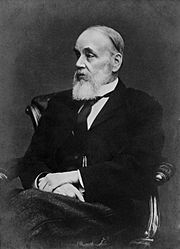Ivan Goncharov facts for kids
Quick facts for kids
Ivan Goncharov
|
|
|---|---|
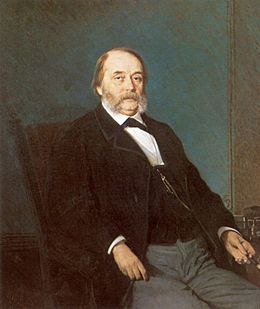
Portrait of Ivan Goncharov by Ivan Kramskoi (1874)
|
|
| Born | Ivan Aleksandrovich Goncharov 18 June 1812 Simbirsk, Russian Empire |
| Died | 27 September 1891 (aged 79) Saint Petersburg, Russian Empire |
| Occupation | Novelist |
| Nationality | Russian |
| Alma mater | Imperial Moscow University (1835) |
| Period | 1847–1871 |
| Notable works | A Common Story (1847) Oblomov (1859) The Precipice (1869) |
| Signature | |
 |
|
Ivan Alexandrovich Goncharov (Russian: Ива́н Алекса́ндрович Гончаро́в; 18 June 1812 – 27 September 1891) was a famous Russian novelist. He is best known for his novels A Common Story (1847), Oblomov (1859), and The Precipice (1869). He also worked in government, even as a censor, deciding what could be published.
Goncharov was born in Simbirsk into a wealthy family. His family was given a special status because of his grandfather's military service. He went to a boarding school and then to Moscow State University. After university, he worked for the government in Simbirsk. Later, he moved to Saint Petersburg. There, he worked as a translator and a private teacher. He also started publishing his own poems and stories. His first novel, A Common Story, came out in 1847.
Goncharov's second and most famous novel, Oblomov, was published in 1859. His third and final novel, The Precipice, was published in 1869. He also wrote reviews about books and plays. Many important writers, like Fyodor Dostoyevsky and Anton Chekhov, thought Goncharov was a very talented author. Chekhov even said Goncharov was "ten heads above me in talent."
Contents
About Ivan Goncharov
His Early Life
Ivan Goncharov was born in Simbirsk, which is now called Ulyanovsk. His father, Alexander Ivanovich Goncharov, was a rich grain merchant (someone who buys and sells goods) and a government official. His father was also the mayor of Simbirsk several times. Their family home was very large, like a country estate, with big barns full of wheat and many stables.
Ivan's father died when Ivan was only seven years old. His mother, Avdotya Matveevna, taught him first. Then, his godfather, Nikolay Nikolayevich Tregubov, helped raise him. Tregubov was a nobleman and a former Russian Navy officer. He had modern ideas and was well-liked by the smart people in Simbirsk. He greatly influenced young Ivan, who especially loved his stories about the sea.
His Education and First Steps as a Writer
From 1820 to 1822, Goncharov went to a private boarding school. There, he learned French and German. He also started reading books by European writers from his teacher's large library. In 1822, Ivan went to Moscow to study at the College of Commerce. He spent eight unhappy years there because he didn't like the teaching or the strict rules. He found comfort in teaching himself.
In 1830, Goncharov decided to leave the college. In 1831, he joined the Moscow State University. He studied literature, arts, and architecture. At the university, he enjoyed the freedom to think and discuss ideas. He was especially excited when the famous poet Alexander Pushkin visited to give a lecture. Goncharov said Pushkin's genius shaped his ideas about art.
In 1834, Goncharov graduated and went back to Simbirsk to work for the governor. A year later, he moved to Saint Petersburg. He started working as a translator for the Finance Ministry. In Saint Petersburg, he became friends with the Maykov family. He taught their sons, Apollon and Valerian Maykov, Latin and Russian literature. He joined a special group of writers at the Maykovs' house, where he met authors like Ivan Turgenev and Fyodor Dostoyevsky. Goncharov wrote many poems for the Maykovs' magazine, Snowdrop, but he soon stopped writing poetry.
His Famous Novels
Goncharov's first story, Evil Illness, was a funny tale published in 1838. Another story, A Fortunate Blunder, came out in 1839. In 1842, he wrote an essay called Ivan Savvich Podzhabrin. This essay showed his skill in describing the lives of ordinary people in the city.
A Common Story
Goncharov's first novel, A Common Story, was published in 1847. It was about a young nobleman from the countryside who comes to Saint Petersburg. The story shows the difference between his overly romantic ideas and the practical, business-focused world of the city. This novel made Goncharov famous. Critics loved it, calling it one of the best Russian books of the year. The word aduyevschina, named after the main character Aduyev, became popular. It described someone who had grand but unrealistic romantic dreams.
In 1849, a part of his next novel, Oblomov, was published as a short story called Oblomov's Dream. It was also praised. However, the full novel would not appear for another ten years.
His Journey and Frigate "Pallada"
In 1852, Goncharov went on a long journey. He traveled through England, Africa, and Japan, and then back to Russia. He was a secretary on the frigate Pallada with Admiral Yevfimy Putyatin. Their mission was to visit places like Alaska and Japan to set up trade. Goncharov kept a detailed diary, which he later used for his book. He returned to Saint Petersburg in 1855, after traveling across Siberia and the Urals.
Goncharov's travel book, Frigate "Pallada", started appearing in magazines in 1855. In 1858, it was published as a separate book and became very popular. For Russian readers in the mid-1800s, this book was amazing. It showed them parts of the world they had never known. Goncharov was a smart writer who understood the history and economy of the places he visited. Critics praised the book for being fair and providing valuable information about different cultures.
Oblomov
Goncharov worked on his second novel, Oblomov, throughout the 1850s. It took a long time to finish. In 1855, he took a job as a censor in Saint Petersburg. This meant he had to approve books before they could be published. He helped publish important works by other writers, which sometimes caused problems with his bosses.
In the summer of 1857, Goncharov went to Marienbad for medical treatment. There, he wrote almost all of Oblomov. He later said, "It had been growing in me for several years, so what I had to do then was just sit and write everything down." Goncharov's second novel Oblomov was published in 1859. It became a Russian classic.
The novel caused a lot of discussion. It introduced a new term, oblomovshchina, to describe a certain type of person. This term refers to someone who is very lazy and unwilling to act, even when they know they should. Critic Nikolay Dobrolyubov explained that oblomovshchina was about social apathy and a self-destructive laziness.
Many famous writers admired Goncharov. Fyodor Dostoyevsky thought he was a very important author. Anton Chekhov said Goncharov was "ten heads above me in talent." Even Ivan Turgenev, who had a disagreement with Goncharov, said, "As long as there is even one Russian alive, Oblomov will be remembered!"
The Precipice
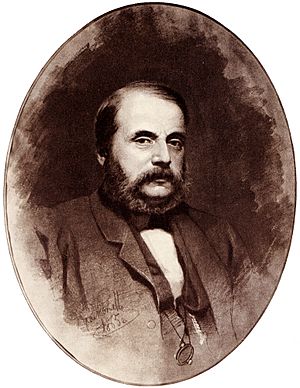
Goncharov was a moderate conservative. He supported the Emancipation reform of 1861, which freed the serfs (farm workers who were tied to the land). In 1862, he became an editor for an official newspaper. A year later, he returned to the censorship committee.
In this role, Goncharov was strict. He made it difficult for some liberal magazines to publish. He openly spoke against new ideas like materialism and socialism, which he called "pathetic, imported doctrines." Because of this, he faced a lot of criticism. All this time, he was working on his third novel, The Precipice.
In 1867, Goncharov left his job as a censor to focus completely on The Precipice. He called it "my heart's child," and it took him twenty years to finish. He sometimes felt it was a "burden" and an "insurmountable task."
In 1869, The Precipice was published. It tells the story of three men competing for love. It also criticizes new ideas that seemed to go against traditional Russian values. Critics later saw this novel as the final part of a series. Each novel introduced a character typical of Russian high society: first Aduev, then Oblomov, and finally Raisky, a talented man who struggles to find his direction.
The novel was quite successful, but some critics did not like it. They felt Goncharov had lost touch with the new Russia. However, others believed that Goncharov's main characters would remain important in history, despite any disagreements.
His Later Years
Goncharov planned a fourth novel, but it was never written. Instead, he became a busy critic, writing many reviews of plays and books. His essay "Myriad of Agonies" (1871) is still considered one of the best essays on Alexandr Griboyedov's play Woe from Wit. Goncharov also wrote short stories about life in rural Russia. In 1880, his complete works were published. After he died, it was discovered that he had burned many of his later writings.
Towards the end of his life, Goncharov wrote a memoir called An Uncommon Story. In it, he claimed that other writers, especially Ivan Turgenev, had copied his ideas. Some people thought this book showed he was not well, while others found it interesting. It was not published until 1924.
Ivan Goncharov never married. He spent his last days feeling sad and bitter about the negative reviews some of his work had received. He died in Saint Petersburg on 27 September 1891, from pneumonia. He was first buried at the Nikolskoe Cemetery and later his remains were moved to the Volkovo Cemetery in Leningrad in 1956.
See also
 In Spanish: Iván Goncharov para niños
In Spanish: Iván Goncharov para niños


